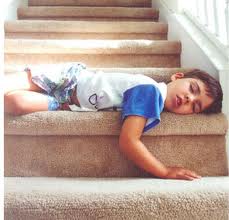 Hitting, fighting, chasing, shooting, killing—these are not only common themes in the news each day, they are also recurrent features of our dreams at night. Few studies have focused specifically on aggression in dreaming, even though Sigmund Freud, the founder of psychoanalysis, claimed that “the inclination to aggression is an original, self-subsisting instinctual disposition in man” (Civilization and its Discontents, 1930). A combination of old and new methods of research can shed light on how this primal instinct plays out in our dreams.
Hitting, fighting, chasing, shooting, killing—these are not only common themes in the news each day, they are also recurrent features of our dreams at night. Few studies have focused specifically on aggression in dreaming, even though Sigmund Freud, the founder of psychoanalysis, claimed that “the inclination to aggression is an original, self-subsisting instinctual disposition in man” (Civilization and its Discontents, 1930). A combination of old and new methods of research can shed light on how this primal instinct plays out in our dreams.
Who Has Aggressive Dreams?
The Hall and Van de Castle system (1966) of dream content analysis has codes for three kinds of social interactions: friendly, sexual, and aggressive. Research using the HVDC system has suggested a few basic patterns in the frequency of aggression in dreams:
- Men have more aggression, especially physical aggression, in their dreams than do women.
- Women are more likely to be victims than initiators of aggression in dreams.
- Children have more aggression in dreams than do adults, especially involving attacks by animals.
- Older people have less aggression in dreams than do younger people.
Hundreds of studies have used the HVDC method over the past several decades, and their findings support the basic idea that aggression is an innate feature of human dreaming.
Why Do We Have Aggressive Dreams?
An additional perspective comes from using word search technologies to identify significant patterns of meaning in dream content. The Sleep and Dream Database (SDDb) has a template with a category for physical aggression, and a large collection of dreams to study for a specific theme like this.
The SDDb Baseline dreams are a good place to start—a set of 5,321 dreams (3,227 females, 2,094 males) that represent a composite portrait of dreaming in general (the reports were given in response to a question about “your most recent dream”). Although limited in many ways, the Baseline dreams offer an empirical basis for making comparisons across different sets of dreams. This can help in identifying trends and patterns that would be difficult to see otherwise.
Applying the word search category for physical aggression to the female Baselines, we find that 15.1% of the dreams include at least one word relating to physical aggression. Applying the same word search category to the male Baselines yields a result of 21.5% of the dreams with at least one reference to physical aggression. (The combined Baselines figure is 17.6%.) So this analysis confirms the finding of the HVDC system that men’s dreams, on average, seem to involve more physical aggression than do women’s dreams. The top ten words used in these dreams were the following: Hit, kill, fight, chasing, killed, shot, fighting, chased, war, shooting.
Turning to the dreams of individuals who have kept track of their dreams for a lengthy period of time, a great deal of variation appears in the frequency of physical aggression. For example, “Tanya,” a young woman, has a relatively high proportion of physical aggression in her dreams (25.4%, in 563 reports), about the same as “Lawrence,” an older man (25.7%, in 206 reports. Another young woman, “Jasmine,” has low physical aggression in her dreams (10.5%, in 800 reports), just like “RB,” an older man (11.8%, in 51 reports).
There is clear evidence that experiences with physical aggression in waking life can increase the frequency of its appearance in dreaming. The best examples are “Mike,” who served as a medic during the Vietnam War and whose collection of dreams includes a very high proportion of physical aggression (76.3%, in 97 reports). In the four sets of dreams from “Beverley” from 1986, 1996, 2006, and 2016, the first set has much more physical aggression (11.9%, in 253 reports) than in the other three (5.7%, in 687 reports), which accurately reflected her involvement in that earlier time period with a violent religious cult.
To help shed light on the role of culture in dreams of physical aggression, the SDDb also includes sets of dreams from non-Western people, which can be analyzed in the same way. For the Mehinaku people of the Amazonian rain forest, a collection of 383 dreams had 22.5% with at least one reference to physical aggression. For a group of Nepalese college students, their dreams (535) had 18.1% with a reference to physical aggression. Three groups of African church members reported dreams (142) with a 19% frequency of physical aggressions. These findings are close enough to the SDDb baselines overall figure of 17.6% to suggest that culture is not a decisive factor in this aspect of dream content.
Concluding Insights
Aggression appears to be a normal feature of human dream content, across different cultures.
Men seem to have more physical aggression in their dreams, although some women have high levels, too.
Dreams of physical aggression can accurately reflect actual aggressions in waking life, so an unusually high level of dream aggression, or a sudden change in dreams to a higher level of aggression, might be a therapeutically valuable sign.
Many dreams of physical aggression do not, however, reflect actual experiences of aggression. These dreams may use violence as a metaphor (e.g., a dream of physical attack as a metaphor of feeling emotionally vulnerable). They may reflect instances of fictional aggression (e.g., seen in a movie). They may be anticipations of violence that may happen at some point in the future (e.g. a threat simulation).
Aggression in dreaming can be viewed as an internal form of play-fighting—the most common form of play in the animal kingdom, and very frequent among humans, too. Play-fighting functions as a way of preparing for future challenges, and also for diminishing and defusing emotional tensions that can lead to actual violence. The same psychological dynamics of play-fighting seem to be operative in dreaming, too.
Note: this post first appeared in Psychology Today, May 31, 2021.

